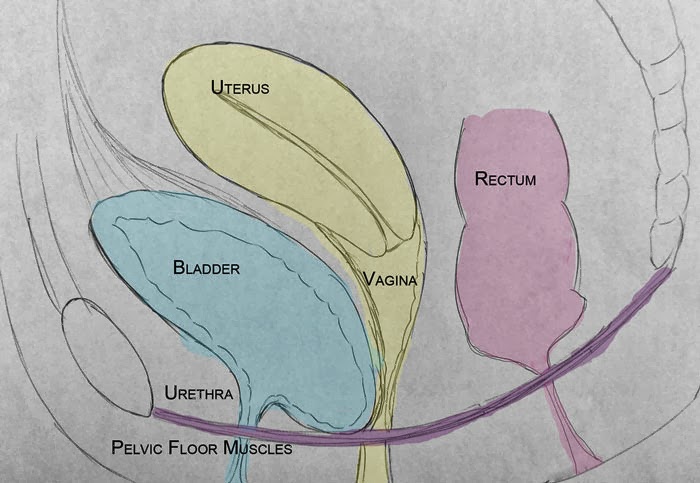Uterine prolapse is a problem that many women face. It is one type of pelvic organ prolapse and it occurs when the support structure for the uterus become unable to hold it into place. Other prolapse issues involve the vagina, bladder and rectum.
It is quite common for women to experience mild prolapse if they have had children, especially if they are approaching menopause. Other factors increase the risk of prolapse, such as:
- delivering larger babies
- prolonged pushing phases during delivery
- multiple deliveries
- chronic constipation and straining
- chronic and prolonged coughing
- hormonal conditions that reduce tone and elasticity of pelvic muscles
- obesity
- pelvic tumors ( this is a rare contributing factor)
- frequent or excessive weight lifting
While uterine prolapse can be an alarming thing to consider, one can take steps to reduce the risk of it developing. And, if it has already occurred, a little knowledge can go a long way in minimizing the impact it has in one’s life.
Basic Overview of Uterine Support and Prolapse
The uterus, or womb, is a muscular organ that sits between the bladder and the rectum. Also called the womb, it is held in its position by a complex system of ligaments, muscles and a support structure that is collectively called the pelvic floor. Under normal circumstances, this system keeps the uterus in place throughout a woman’s life.
The uterus is a dynamic organ that can endure a lot of change and stress due to menstrual cycles, pregnancy and childbirth. Over time, however, the muscles and ligaments that support the womb can become weak and allow the uterus to sag out of place. There are many factors that contribute to the development of uterine prolapse.
When the uterus prolapses, it slips out of its normal location and down into the vagina. There are different levels of prolapse, ranging from very mild to severe. A first degree prolapse means the cervix, the opening to the uterus, has sipped into the upper portion of the vagina. A fourth degree prolapse is when the uterus has slipped all the way down and protrudes out of the vagina.
Symptoms of Uterine Prolapse
If a prolapse is mild, there might be no real symptoms and a woman might not know that anything has changed inside her body. And, while a mild prolapse doesn’t require medical intervention, a woman can still take steps to keep it from deteriorating into a more severe prolapse.
It is when a prolapse becomes more moderate that symptoms become evident. Depending upon the severity of the prolapse, a woman can experience a wide range of symptoms. Not everyone will experience every symptom, but one might feel any combination of the following symptoms:
- feeling of heaviness in the pelvis or pulling sensation in the groin
- feeling that something is inside the vagina or a sense of fullness
- feeling that you’re sitting on a small ball
- chronic difficulty having a bowel movement
- urinary difficulty such as leaking, retention and urgency
- pain during intercourse, especially with deep penetration
- increased vaginal discharge or bleeding
- discomfort when walking or standing long period
Symptoms might be more noticeable when a woman is standing up, coughing, laughing or while going to the bathroom. They might notice that the symptoms are more mild or go away altogether when they lay down. Often times women have mild symptoms in the morning which worsen during the course of the day.
Prevention and Treatment for Uterine Prolapse
If a prolapse is mild, there is generally no treatment required. Kegel exercises, however, can help tone the pelvic muscles that support the uterus to reduce prolapse severity. These exercises involve tightening and releasing the muscles of the pelvic floor. To do them, tighten and release pelvic muscles, as one would to stop urinating midstream. There are kits, books, videos and devices that can help teach proper Kegel technique.
Moderate to severe prolapse requires the care of a physician to determine the best treatment approach. A pessary is a supportive device that fits inside the vagina and helps maintain normal uterine position. These devices are prescribed and fitted by a doctor. They aren’t right for everybody and can cause irritation, discharge and other problems.
Under the right circumstances, surgery is an option for severe prolapse. Surgery can repair the prolapse, artificially suspending the uterus and restoring normal anatomy. Hysterectomy is also an option for some if they are past childbearing age. Before settling on surgery, one should consult a variety of doctors as there are different techniques used to repair uterine prolapse.
Prolapse problems are difficult to deal with because they come with shame and embarrassment. Uterine prolapse is particularly hard to cope with since it strikes at the very heart of femininity, the womb. However, it’s important to catch prolapse issues early so measures can be taken to reduce their progress. Above all, women should know that millions of women share their struggle and are living full life regardless of uterine prolapse.









